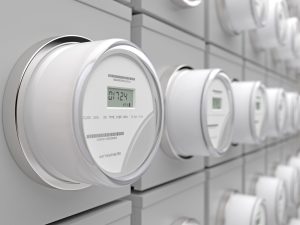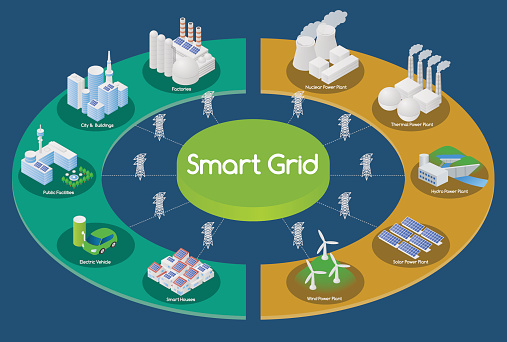Introduction: is a Smart Grid?
Electrical power distribution systems, known as electrical grids, have been the linchpins global electricity supply since the late 19th century. Initially designed with straightforward principles, these grids generated electricity at a central point and it to homes, businesses, and other areas of demand. However, the escalating demand for electricity underscores the need for more efficient and sophisticated electrical grids. Enter the modern “smart grid”—a transformative system leveraging cutting-edge technologies to optimize energy distribution and consumption.
What Is Smart Grid Technology?

Smart grid technology represents a significant evolution from traditional electrical power distribution systems. Unlike the conventional one-way delivery of power from utility providers to consumers, smart grids incorporate advanced two-way communication, enabling a dynamic and interactive energy distribution network. This means that not only does electricity flow from power plants to households and businesses, but data about energy usage, demands, and system health also flows back to utility providers. This exchange of information in real-time is what makes the grid “smart”.
Key Components of Smart Grid Technology
Several core components work together to make a grid “smart” by enhancing its efficiency, reliability, and adaptability:
-
Power/Current Sensors:
- These sensors are strategically placed throughout the grid and continuously monitor the flow of electricity. They detect fluctuations in power quality and can identify outages the moment they occur. This real-time data is crucial for maintaining grid stability.
-
Control Systems:
- Control systems manage the distribution of electricity based on the data gathered from sensors. They can reroute power, balance loads, and manage the integration of renewable energy sources. These systems are vital for adapting to changing energy demands instantaneously.
-
Data Centers:
- Data centers act as the brain of the smart grid, processing vast amounts of information collected from sensors across the grid. They perform complex analyses to forecast energy needs, detect inefficiencies, and plan maintenance. The insights gained from these analyses are used to improve energy distribution and grid management.
-
Smart Meters:
- Smart meters are installed at consumers’ premises and provide detailed information on energy consumption patterns. Unlike traditional meters, smart meters measure and communicate real-time data back to the utility providers. This helps consumers manage their energy usage more effectively and allows utilities to optimize energy provisioning.
Complexity and Regional Variation
The transition to smart grids varies significantly around the world, influenced by factors such as technological readiness, regulatory environments, and economic conditions. Here are a few reasons why smart grid implementation can be complex and time-consuming:
-
Technological Integration:
- Integrating new technologies with existing infrastructure is a complex task that requires significant investments in new equipment and systems.
-
Regulatory Hurdles:
- Different regions have varying regulations regarding data privacy, energy distribution, and infrastructure changes, which can impact the speed and scope of smart grid implementation.
-
Economic Factors:
- The upfront cost of upgrading to a smart grid can be substantial. Governments and utility companies must balance these costs against the long-term benefits of improved efficiency and reliability.
-
Consumer Adoption:
- Public acceptance and adoption of new technologies like smart meters play a critical role. Educating consumers about the benefits and encouraging participation is essential for the success of smart grid systems.
A smart grid is a sophisticated, responsive, and highly efficient power distribution system enabled by advances in sensor technology, control mechanisms, comprehensive data analysis, and enhanced communication between utilities and consumers. Despite the challenges in implementation, the benefits of smart grids—including increased efficiency, better reliability, and the integration of renewable energy sources—make them a pivotal part of future energy distribution networks.
Components of Smart Grid Technology

Smart Meters
Smart meters represent the first step in smart grid implementation. These devices deliver real-time energy consumption data to both consumers and producers, promoting energy efficiency by identifying and reducing wasted energy. Smart meters generally comprise three subsystems:
- Power system that measures energy consumption.
- Microcontroller managing smart meter functionalities.
- Communication system for transmitting and receiving data.
Additional features may include backup power sources and GSM modules for location tracking. Global investment in smart meters has witnessed a remarkable increase, from $11 million in 2014 to $21 million in 2019, reflecting their substantial system-efficiency benefits.
Smart Load Control Switches and Distribution Boards
Though smart meters provide valuable real-time data, they do not automatically control energy distribution. Smart load control switches and distribution boards fill this gap by managing energy during peak times and optimizing distribution. These devices can reduce unnecessary energy use and manage loads exceeding their time-of-use limits.
For example, Wadsworth, Ohio, utilized smart load control switches on a 1916-built electric distribution system to reduce usage by 5,300 megawatt-hours. saves energy by cycling A/C compressors during peak demand, demonstrating a practical application power control systems.
Power System Automation
Power system automation refers to the utilization of smart grid technologies to control every step of power distribution. Components include:
- Intelligent data acquisition systems (e.g., smart meters)
- Power control systems (e.g., smart load control switches)
- Analytical and computational tools
- Power system algorithms
By integrating these elements, a smart grid can autonomously adjust and optimize itself with minimal human intervention.
Infrastructure Changes Enabled by Smart Grid Implementation

Implementing smart grid infrastructure allows for several transformative changes:
Decentralized Energy Production
Smart grids enable continuous monitoring and control of energy distribution, making single, large power plants unnecessary. Decentralized energy production can take place through various means, including:
- Wind turbines
- Solar farms
- Residential photovoltaic solar panels
- Small hydroelectric dams
Decentralized Markets
Smart grids also enable the interconnection of multiple grids for effective energy distribution. Historically, municipalities operated independent production facilities, disconnected from adjacent areas. Smart grid infrastructure facilitates shared production schedules and reduces dependencies, mitigating the risk of outages.
Small-Scale Transmission
Energy loss during long-distance transmission has been one of the most significant inefficiencies in traditional electrical grids. Smart grids reduce transmission distances, thereby cutting energy losses. For example, a local neighborhood solar farm can facilitate energy distribution with far less loss compared to a distant power plant.
Two-Way Distribution
In a smart grid, surplus energy generated by local sources (e.g., a solar farm) can be redistributed to the main grid. This bi-directional energy flow ensures that surplus energy can reduce demand on centralized power plants. Power distribution algorithms can monitor and optimize this flow to minimize energy waste.
Consumer Participation
Smart grid infrastructure promotes consumer participation as energy generators. Individual homes equipped with independent PV solar systems can contribute surplus energy back into the grid, further reducing demand on larger power plants.
The Importance of Smart Grids
Adopting smart grid infrastructure is imperative for reducing power consumption at a macroeconomic level. Utilities and governments offer generous incentives for smart grid adoption due to the following benefits:
Democratization of Energy Production
Adopting smart grids democratizes energy production, reducing the reliance on large, centralized power plants and promoting energy independence for smaller producers.
Risk Mitigation
Smart grid implementation mitigates the risk of outages through decentralized energy production and market structures.
Cost Reduction
By optimizing energy distribution and reducing waste, smart grids lower operating costs for power systems.
Environmental Benefits
Efficient energy use and reduced waste contribute to lower carbon emissions, making smart grids an environmentally responsible choice.
Conclusion
The transition to smart grids represents a significant evolution in power distribution. By leveraging digital technologies and two-way communication, smart grids optimize energy use, reduce waste, and enable decentralized energy production. From smart meters to power system automation, these advancements promise a future where energy is used more efficiently and sustainably. As countries continue to invest in smart grid infrastructure, the benefits—both economic and environmental—will become increasingly evident, making this a crucial step toward a more sustainable future.










